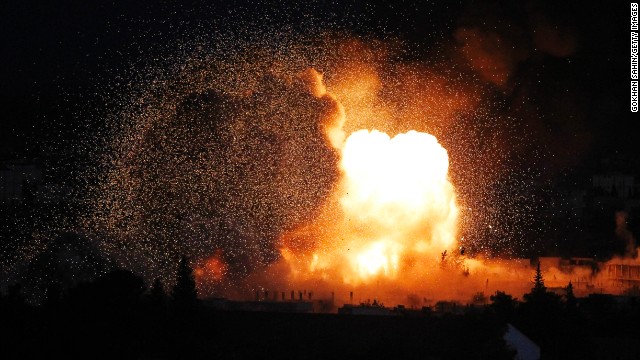 An explosion rocks Kobani, Syria, during a reported car-bomb attack by ISIS militants on Monday, October 20. Civil war has destabilized Syria and created an opening for the militant group, which is also advancing in Iraq as it seeks to create an Islamic caliphate in the region.
An explosion rocks Kobani, Syria, during a reported car-bomb attack by ISIS militants on Monday, October 20. Civil war has destabilized Syria and created an opening for the militant group, which is also advancing in Iraq as it seeks to create an Islamic caliphate in the region. 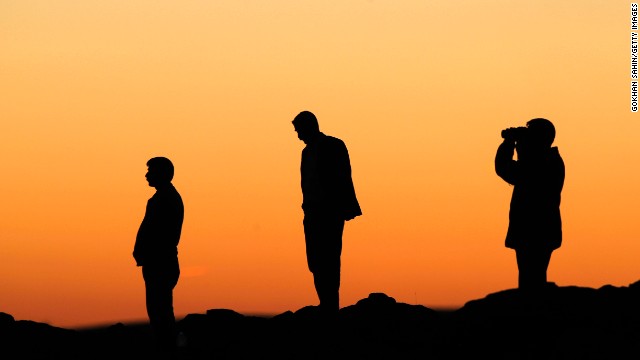 People watch the Syrian town of Kobani from a hill near the Turkey-Syria border on October 20.
People watch the Syrian town of Kobani from a hill near the Turkey-Syria border on October 20. 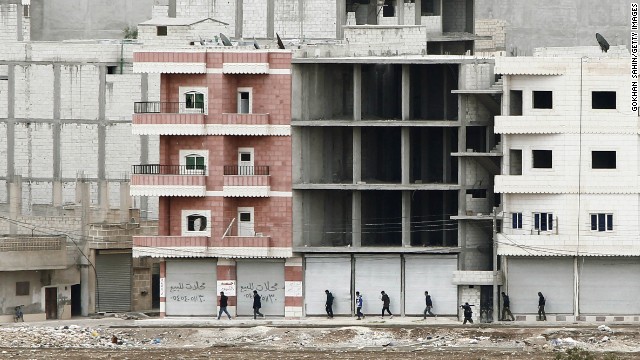 Kurdish fighters walk to positions as they fight ISIS forces in Kobani on Sunday, October 19.
Kurdish fighters walk to positions as they fight ISIS forces in Kobani on Sunday, October 19. 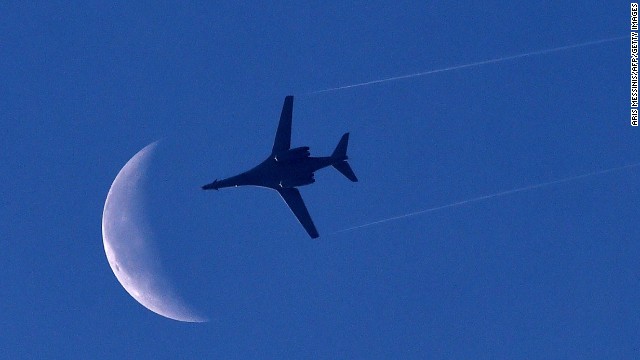 A U.S. Air Force plane flies above Kobani on Saturday, October 18. The United States and several Arab nations have been bombing ISIS targets in Syria to take out the militant group's ability to command, train and resupply its fighters.
A U.S. Air Force plane flies above Kobani on Saturday, October 18. The United States and several Arab nations have been bombing ISIS targets in Syria to take out the militant group's ability to command, train and resupply its fighters. 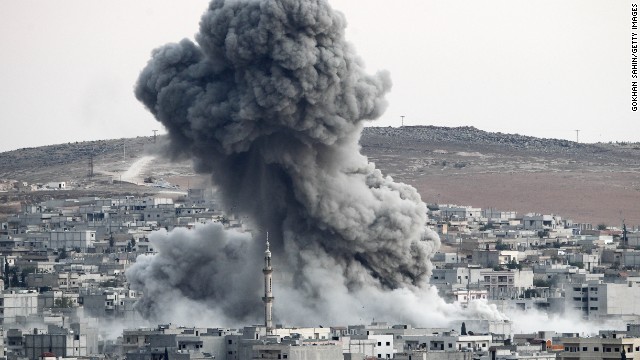 Heavy smoke rises in Kobani following an airstrike by the U.S.-led coalition on Saturday, October 18.
Heavy smoke rises in Kobani following an airstrike by the U.S.-led coalition on Saturday, October 18.  Cundi Minaz, a female Kurdish fighter, is buried in a cemetery in the southeastern Turkish town of Suruc on Tuesday, October 14. Minaz was reportedly killed during clashes with ISIS militants in nearby Kobani.
Cundi Minaz, a female Kurdish fighter, is buried in a cemetery in the southeastern Turkish town of Suruc on Tuesday, October 14. Minaz was reportedly killed during clashes with ISIS militants in nearby Kobani.  Turkish police officers secure a basketball stadium in Suruc on October 14. Some Syrian Kurds have been held there since crossing from Syria into Turkey. Tens of thousands of people have fled Kobani, known in Arabic as Ayn al-Arab, to escape ISIS.
Turkish police officers secure a basketball stadium in Suruc on October 14. Some Syrian Kurds have been held there since crossing from Syria into Turkey. Tens of thousands of people have fled Kobani, known in Arabic as Ayn al-Arab, to escape ISIS. 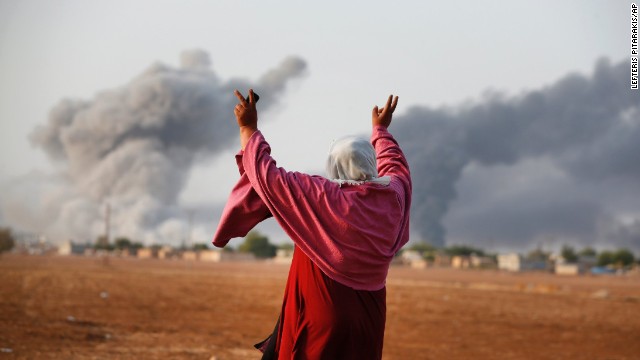 Kiymet Ergun, a Syrian Kurd, celebrates in Mursitpinar, Turkey, after an airstrike by the U.S.-led coalition in Kobani on Monday, October 13.
Kiymet Ergun, a Syrian Kurd, celebrates in Mursitpinar, Turkey, after an airstrike by the U.S.-led coalition in Kobani on Monday, October 13. 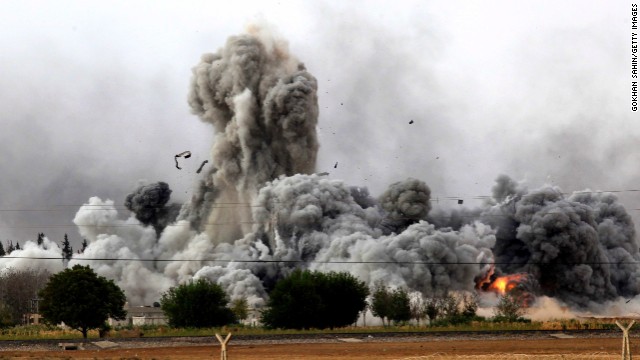 Smoke rises from Kobani on Sunday, October 12.
Smoke rises from Kobani on Sunday, October 12. 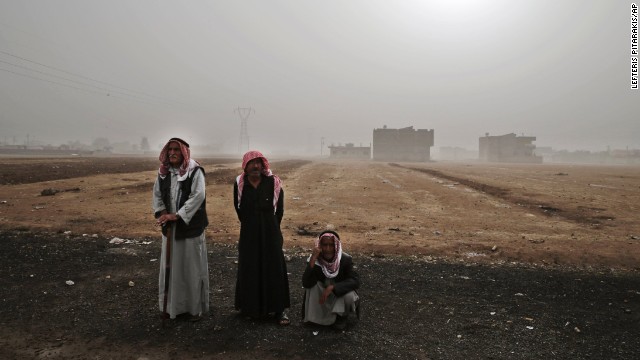 Syrian Kurds from Kobani stand outside the grounds of a refugee camp in Suruc on Saturday, October 11.
Syrian Kurds from Kobani stand outside the grounds of a refugee camp in Suruc on Saturday, October 11. 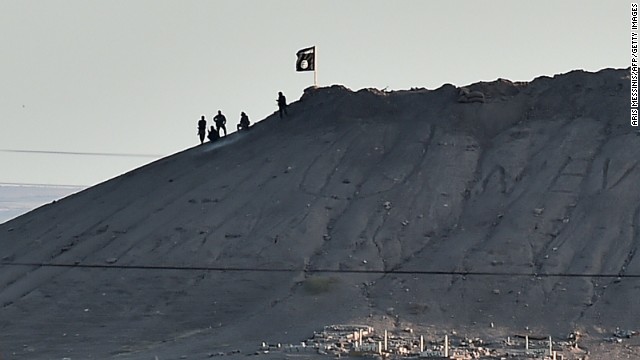 Alleged ISIS militants stand next to an ISIS flag atop a hill in Kobani on Monday, October 6.
Alleged ISIS militants stand next to an ISIS flag atop a hill in Kobani on Monday, October 6. 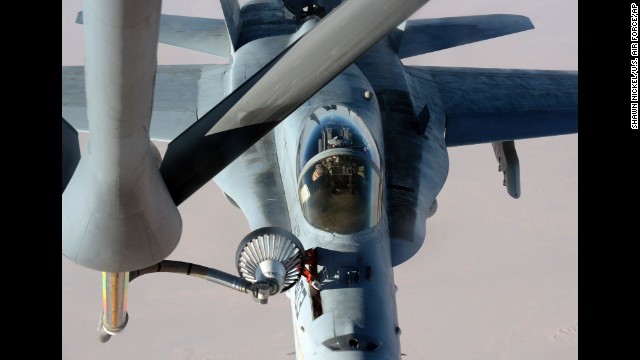 In this photo released by the U.S. Air Force on Saturday, October 4, a U.S. Navy jet is refueled in Iraqi airspace after conducting an airstrike against ISIS militants.
In this photo released by the U.S. Air Force on Saturday, October 4, a U.S. Navy jet is refueled in Iraqi airspace after conducting an airstrike against ISIS militants. 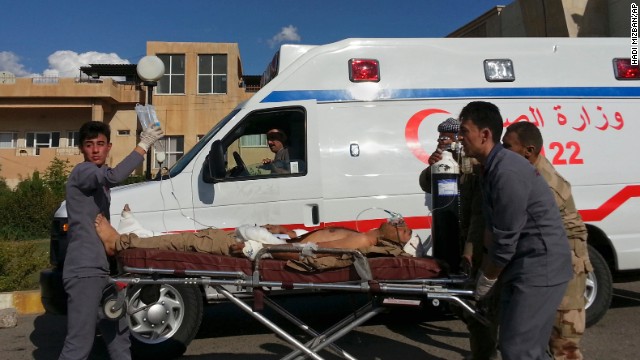 A Kurdish Peshmerga soldier who was wounded in a battle with ISIS is wheeled to the Zakho Emergency Hospital in Duhuk, Iraq, on Tuesday, September 30.
A Kurdish Peshmerga soldier who was wounded in a battle with ISIS is wheeled to the Zakho Emergency Hospital in Duhuk, Iraq, on Tuesday, September 30. 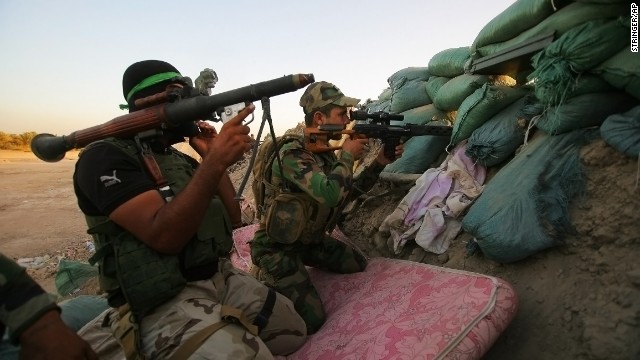 Iraqi Shiite militiamen aim their weapons during clashes with ISIS militants in Jurf al-Sakhar, Iraq, on Sunday, September 28.
Iraqi Shiite militiamen aim their weapons during clashes with ISIS militants in Jurf al-Sakhar, Iraq, on Sunday, September 28.  Syrian Kurds wait near a border crossing in Suruc as they wait to return to their homes in Kobani on Sunday, September 28. Tens of thousands of people have fled Kobani, known in Arabic as Ayn al-Arab, to escape ISIS.
Syrian Kurds wait near a border crossing in Suruc as they wait to return to their homes in Kobani on Sunday, September 28. Tens of thousands of people have fled Kobani, known in Arabic as Ayn al-Arab, to escape ISIS. 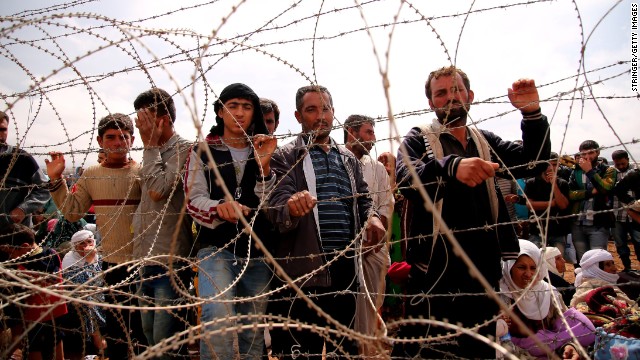 Syrian Kurds wait behind border fences to cross into Suruc on September 28.
Syrian Kurds wait behind border fences to cross into Suruc on September 28. 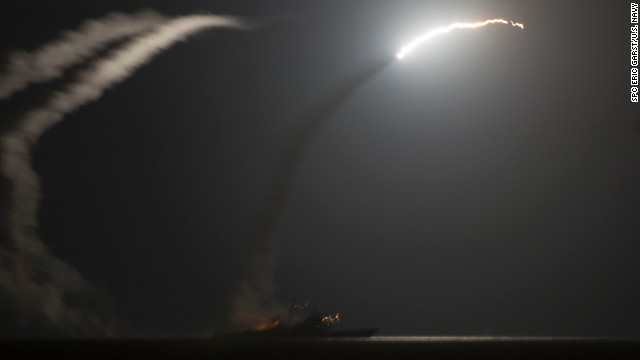 Tomahawk missiles, intended for ISIS targets in Syria, fly above the Persian Gulf after being fired by the USS Philippine Sea in this image released by the U.S. Navy on Tuesday, September 23.
Tomahawk missiles, intended for ISIS targets in Syria, fly above the Persian Gulf after being fired by the USS Philippine Sea in this image released by the U.S. Navy on Tuesday, September 23. 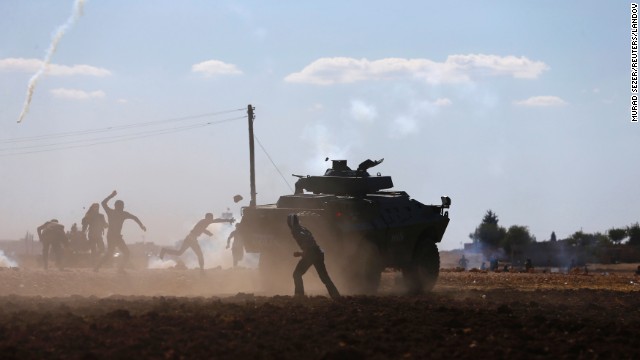 Turkish Kurds clash with Turkish security forces during a protest near Suruc on Monday, September 22. According to Time magazine, the protests were over Turkey's temporary decision to close the border with Syria.
Turkish Kurds clash with Turkish security forces during a protest near Suruc on Monday, September 22. According to Time magazine, the protests were over Turkey's temporary decision to close the border with Syria.  Syrian Kurds fleeing ISIS militants wait behind a fence in Suruc on Sunday, September 21.
Syrian Kurds fleeing ISIS militants wait behind a fence in Suruc on Sunday, September 21. 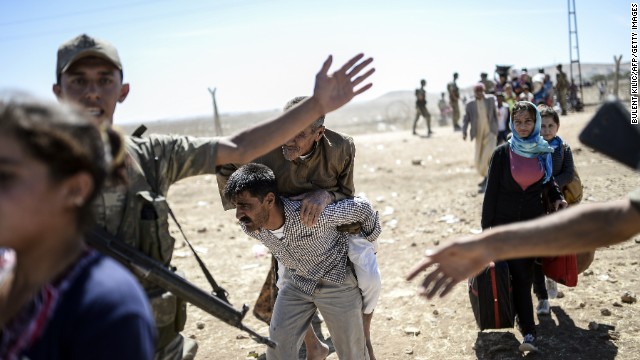 A elderly man is carried after crossing the Syria-Turkey border near Suruc on Saturday, September 20.
A elderly man is carried after crossing the Syria-Turkey border near Suruc on Saturday, September 20. 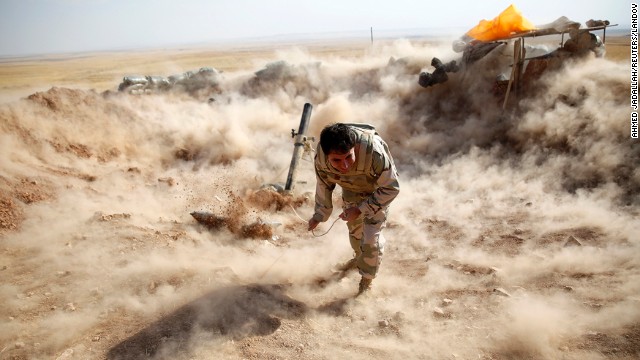 A Kurdish Peshmerga fighter launches mortar shells toward ISIS militants in Zumar, Iraq, on Monday, September 15.
A Kurdish Peshmerga fighter launches mortar shells toward ISIS militants in Zumar, Iraq, on Monday, September 15. 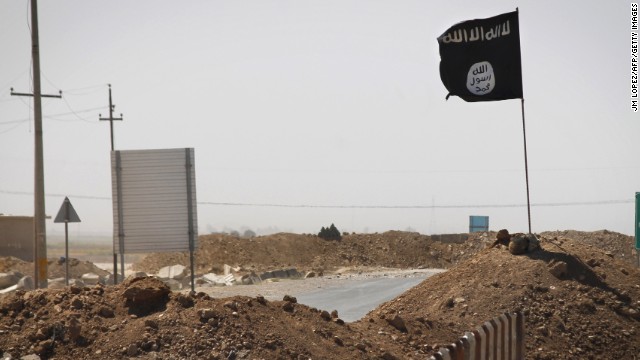 An ISIS flag flies on the other side of a bridge at the front line of fighting between ISIS and Kurdish Peshmerga fighters in Rashad, Iraq, on Thursday, September 11.
An ISIS flag flies on the other side of a bridge at the front line of fighting between ISIS and Kurdish Peshmerga fighters in Rashad, Iraq, on Thursday, September 11. 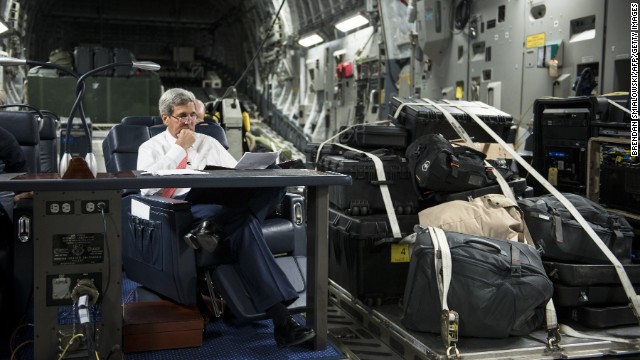 U.S. Secretary of State John Kerry reads on a flight en route to Iraq on Wednesday, September 10. Kerry traveled to the Mideast to discuss ways to bolster the stability of the new Iraqi government and combat ISIS.
U.S. Secretary of State John Kerry reads on a flight en route to Iraq on Wednesday, September 10. Kerry traveled to the Mideast to discuss ways to bolster the stability of the new Iraqi government and combat ISIS. 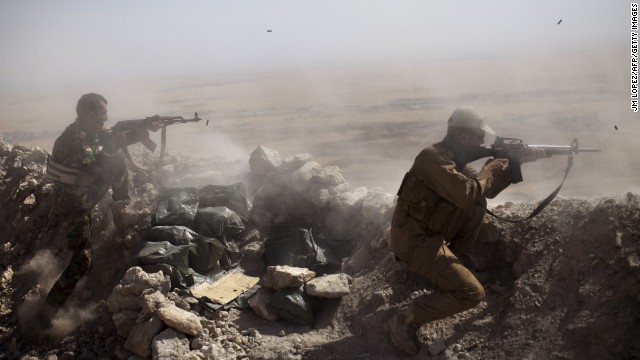 Kurdish Peshmerga fighters fire at ISIS militant positions from their position on the top of Mount Zardak, east of Mosul, Iraq, on Tuesday, September 9.
Kurdish Peshmerga fighters fire at ISIS militant positions from their position on the top of Mount Zardak, east of Mosul, Iraq, on Tuesday, September 9.  An Iraqi fighter jet flies over Amerli, Iraq, on September 3. Amerli had been under siege by ISIS militants.
An Iraqi fighter jet flies over Amerli, Iraq, on September 3. Amerli had been under siege by ISIS militants. 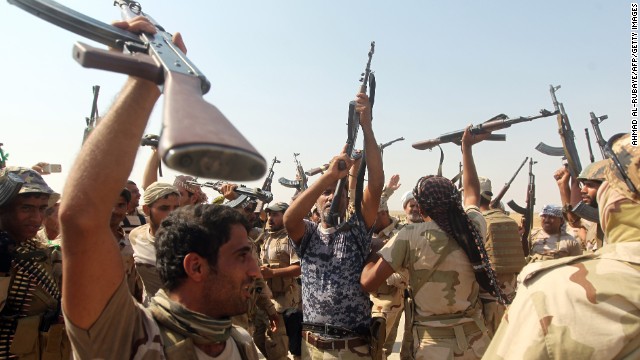 Iraqi volunteer fighters celebrate breaking the Amerli siege on Monday, September 1. ISIS militants had surrounded Amerli, 70 miles north of Baquba, Iraq, since mid-June.
Iraqi volunteer fighters celebrate breaking the Amerli siege on Monday, September 1. ISIS militants had surrounded Amerli, 70 miles north of Baquba, Iraq, since mid-June. 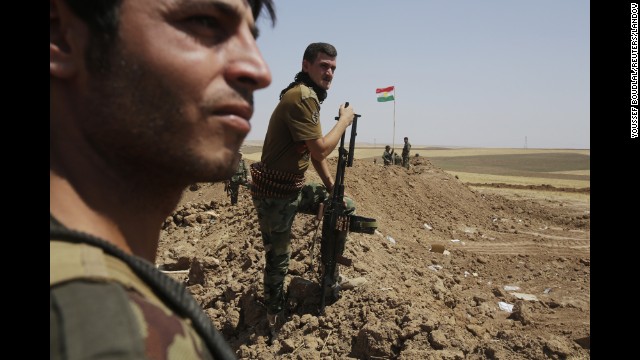 Kurdish Peshmerga forces stand guard at their position in the Omar Khaled village west of Mosul on Sunday, August 24.
Kurdish Peshmerga forces stand guard at their position in the Omar Khaled village west of Mosul on Sunday, August 24. 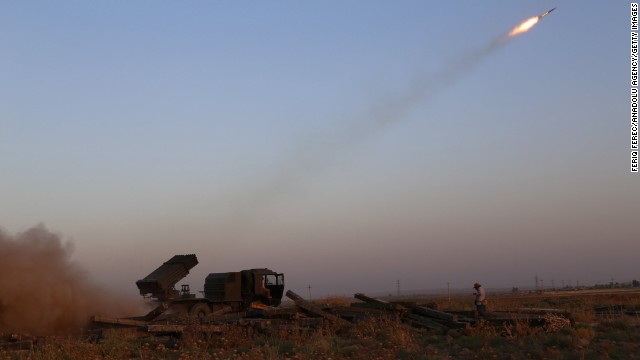 Kurdish Peshmergas fight to regain control of the town of Celavle, in Iraq's Diyala province, on August 24.
Kurdish Peshmergas fight to regain control of the town of Celavle, in Iraq's Diyala province, on August 24. 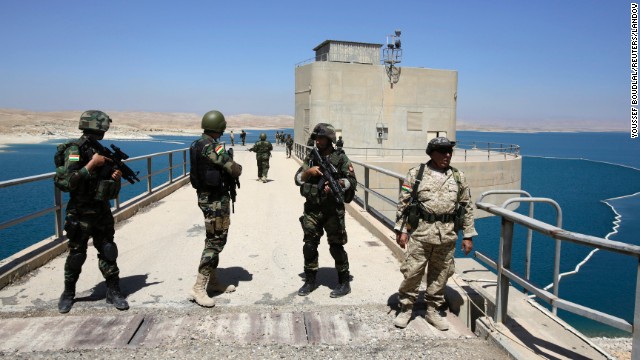 Peshmerga fighters stand guard at Mosul Dam in northern Iraq on Thursday, August 21. With the help of U.S. military airstrikes, Kurdish and Iraqi forces retook the dam from ISIS militants on August 18. A breach of the dam would have been catastrophic for millions of Iraqis who live downstream from it.
Peshmerga fighters stand guard at Mosul Dam in northern Iraq on Thursday, August 21. With the help of U.S. military airstrikes, Kurdish and Iraqi forces retook the dam from ISIS militants on August 18. A breach of the dam would have been catastrophic for millions of Iraqis who live downstream from it.  Displaced Iraqis receive clothes from a charity at a refugee camp near Feeshkhabour, Iraq, on Tuesday, August 19.
Displaced Iraqis receive clothes from a charity at a refugee camp near Feeshkhabour, Iraq, on Tuesday, August 19.  A fighter with Kurdish Peshmerga forces battles ISIS militants near Mosul on Monday, August 18.
A fighter with Kurdish Peshmerga forces battles ISIS militants near Mosul on Monday, August 18.  Peshmerga fighters inspect the remains of a car that reportedly belonged to ISIS militants and was targeted by a U.S. airstrike in the village of Baqufa, north of Mosul, on August 18.
Peshmerga fighters inspect the remains of a car that reportedly belonged to ISIS militants and was targeted by a U.S. airstrike in the village of Baqufa, north of Mosul, on August 18. 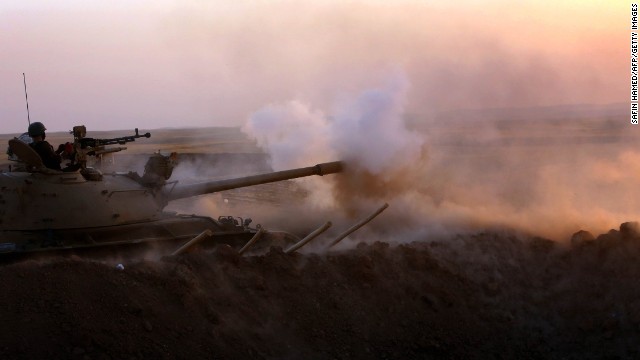 Kurdish Peshmerga fighters fire at ISIS in Khazair, Iraq, on Thursday, August 14.
Kurdish Peshmerga fighters fire at ISIS in Khazair, Iraq, on Thursday, August 14.  Volunteers of the Iraqi Red Crescent Society unload boxes of goods before distributing them August 14 to families who fled from ISIS.
Volunteers of the Iraqi Red Crescent Society unload boxes of goods before distributing them August 14 to families who fled from ISIS. 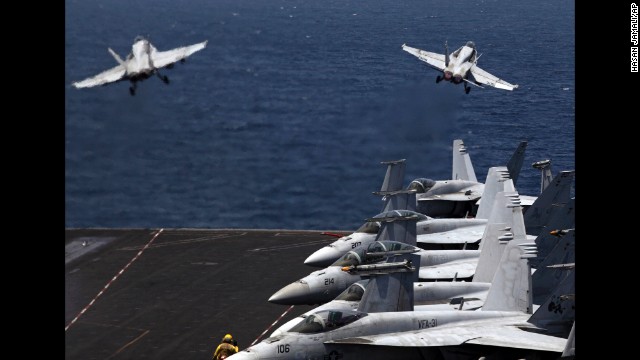 From the flight deck of the USS George H.W. Bush, which is in the Persian Gulf, two U.S. fighter jets take off for a mission in Iraq on Monday, August 11. U.S. President Barack Obama authorized airstrikes against Islamic militants and food drops for Iraqis who are trapped by the militants.
From the flight deck of the USS George H.W. Bush, which is in the Persian Gulf, two U.S. fighter jets take off for a mission in Iraq on Monday, August 11. U.S. President Barack Obama authorized airstrikes against Islamic militants and food drops for Iraqis who are trapped by the militants. 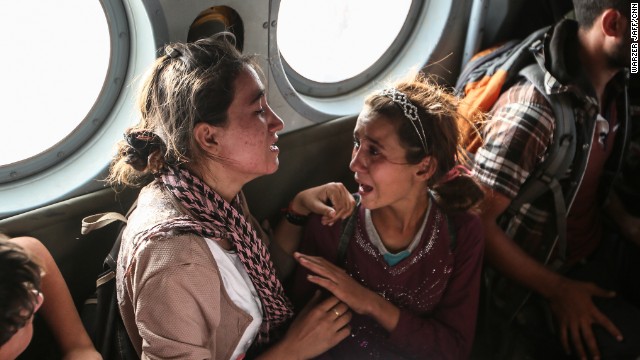 Aziza Hamid, a 15-year-old Iraqi girl, cries for her father while she and some other Yazidi people are flown to safety Monday, August 11, after a dramatic rescue operation at Iraq's Mount Sinjar. A CNN crew was on the flight, which took diapers, milk, water and food to the site where as many as 70,000 people were trapped by ISIS. But only a few of them were able to fly back on the helicopter with the Iraqi Air Force and Kurdish Peshmerga fighters.
Aziza Hamid, a 15-year-old Iraqi girl, cries for her father while she and some other Yazidi people are flown to safety Monday, August 11, after a dramatic rescue operation at Iraq's Mount Sinjar. A CNN crew was on the flight, which took diapers, milk, water and food to the site where as many as 70,000 people were trapped by ISIS. But only a few of them were able to fly back on the helicopter with the Iraqi Air Force and Kurdish Peshmerga fighters. 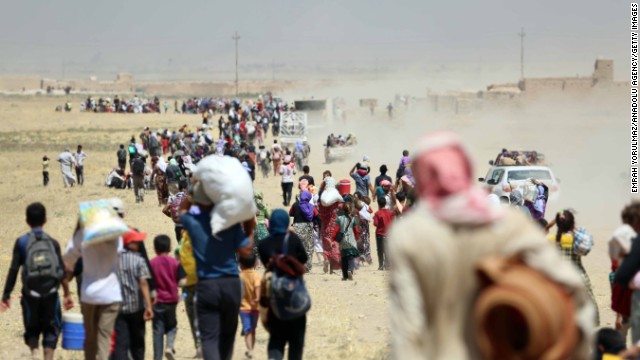 Thousands of Yazidis are escorted to safety by Kurdish Peshmerga forces and a People's Protection Unit in Mosul on Saturday, August 9.
Thousands of Yazidis are escorted to safety by Kurdish Peshmerga forces and a People's Protection Unit in Mosul on Saturday, August 9. 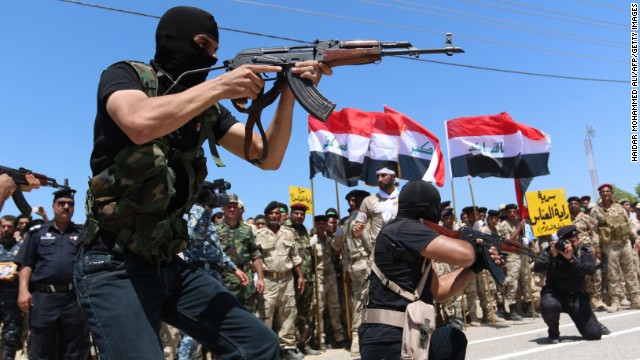 Iraqi Shiite volunteers who have joined government forces to fight ISIS take part in a training session near Basra, Iraq, on Thursday, August 7.
Iraqi Shiite volunteers who have joined government forces to fight ISIS take part in a training session near Basra, Iraq, on Thursday, August 7. 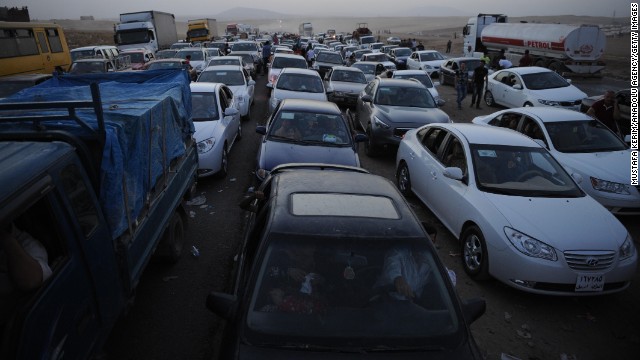 Thousands of Yazidi and Christian people flee Mosul on Wednesday, August 6, after the latest wave of ISIS advances.
Thousands of Yazidi and Christian people flee Mosul on Wednesday, August 6, after the latest wave of ISIS advances. 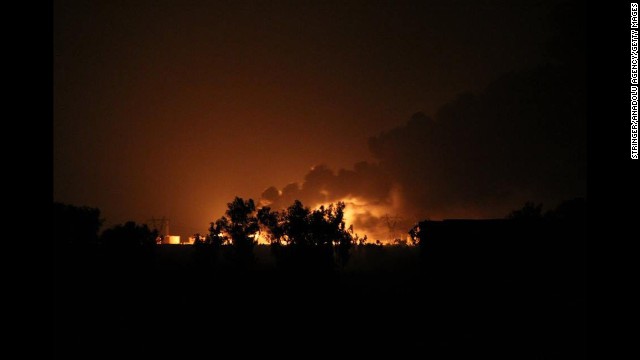 A Baiji oil refinery burns after an alleged ISIS attack in northern Selahaddin, Iraq, on Thursday, July 31.
A Baiji oil refinery burns after an alleged ISIS attack in northern Selahaddin, Iraq, on Thursday, July 31. 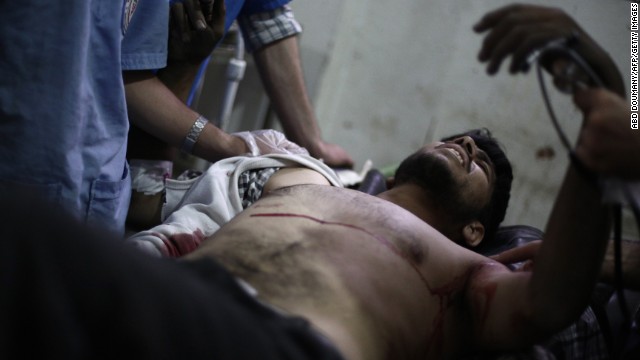 A Syrian rebel fighter lies on a stretcher at a makeshift hospital in Douma, Syria, on Wednesday, July 9. He was reportedly injured while fighting ISIS militants.
A Syrian rebel fighter lies on a stretcher at a makeshift hospital in Douma, Syria, on Wednesday, July 9. He was reportedly injured while fighting ISIS militants.  Iraqis who fled fighting in the cities of Mosul and Tal Afar try to enter a temporary displacement camp in Khazair on Wednesday, July 2.
Iraqis who fled fighting in the cities of Mosul and Tal Afar try to enter a temporary displacement camp in Khazair on Wednesday, July 2.  Peshmerga fighters check cars at the entrance of a temporary displacement camp in Khazair on Thursday, June 26.
Peshmerga fighters check cars at the entrance of a temporary displacement camp in Khazair on Thursday, June 26. 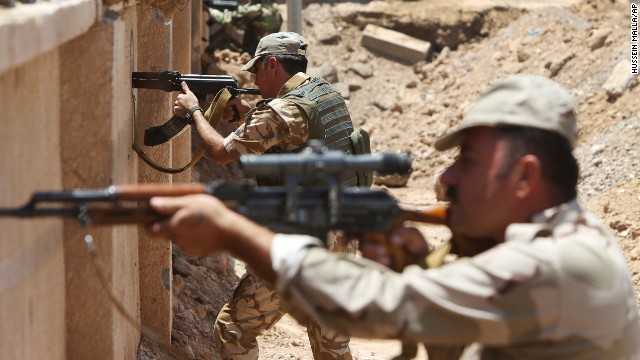 Kurdish Peshmerga take their positions behind a wall on the front line of the conflict with ISIS militants in Tuz Khormato, Iraq, on Wednesday, June 25.
Kurdish Peshmerga take their positions behind a wall on the front line of the conflict with ISIS militants in Tuz Khormato, Iraq, on Wednesday, June 25.  Peshmerga fighters clean their weapons at a base in Tuz Khormato on June 25.
Peshmerga fighters clean their weapons at a base in Tuz Khormato on June 25. 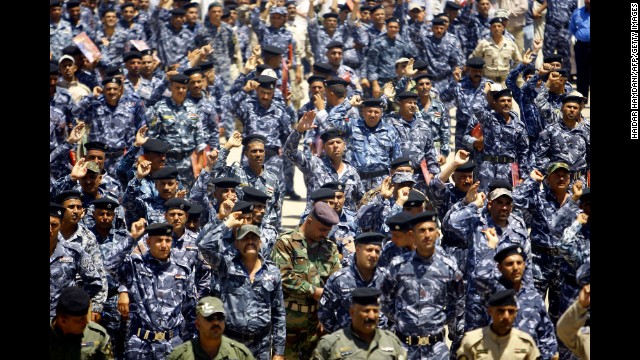 New army recruits gather in Najaf, Iraq, on Wednesday, June 18, following a call for Iraqis to take up arms against Islamic militant fighters.
New army recruits gather in Najaf, Iraq, on Wednesday, June 18, following a call for Iraqis to take up arms against Islamic militant fighters.  An MH-60R Sea Hawk helicopter lands on the aircraft carrier USS George H.W. Bush in the Persian Gulf on Tuesday, June 17.
An MH-60R Sea Hawk helicopter lands on the aircraft carrier USS George H.W. Bush in the Persian Gulf on Tuesday, June 17. 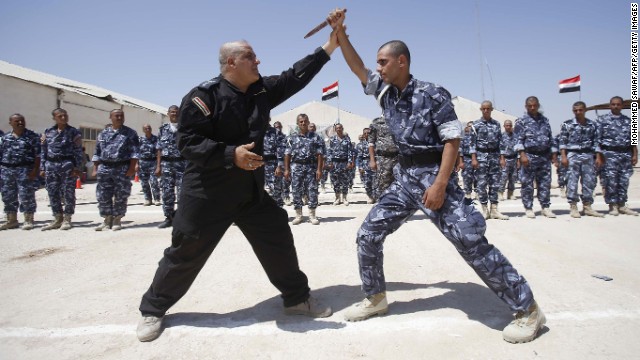 Newly recruited Iraqi volunteer fighters take part in a training session in Karbala, Iraq, on June 17.
Newly recruited Iraqi volunteer fighters take part in a training session in Karbala, Iraq, on June 17. 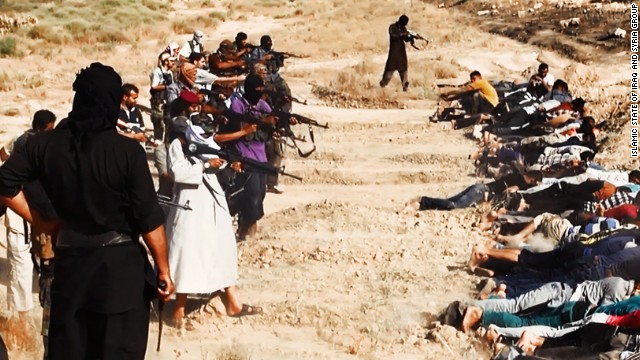 Members of ISIS prepare to execute soldiers from Iraq's security forces in this image, one of many reportedly posted by the militant group online. CNN cannot independently confirm the authenticity of the images.
Members of ISIS prepare to execute soldiers from Iraq's security forces in this image, one of many reportedly posted by the militant group online. CNN cannot independently confirm the authenticity of the images. 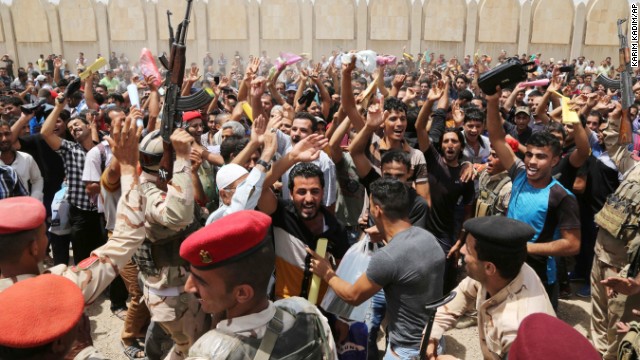 Iraqi men chant slogans outside of an army recruiting center to volunteer for military service Thursday, June 12, in Baghdad.
Iraqi men chant slogans outside of an army recruiting center to volunteer for military service Thursday, June 12, in Baghdad. 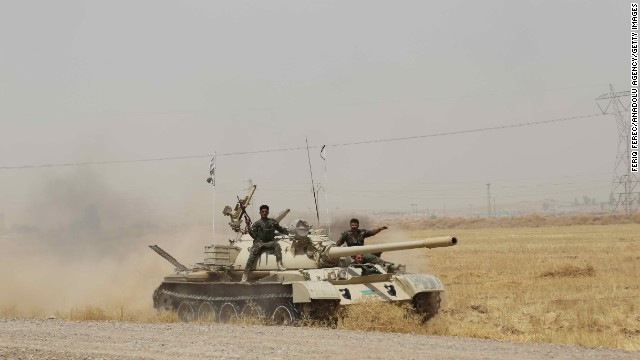 Kurdish Peshmerga forces, along with Iraqi special forces, deploy their troops and armored vehicles outside of Kirkuk, Iraq, on June 12.
Kurdish Peshmerga forces, along with Iraqi special forces, deploy their troops and armored vehicles outside of Kirkuk, Iraq, on June 12. 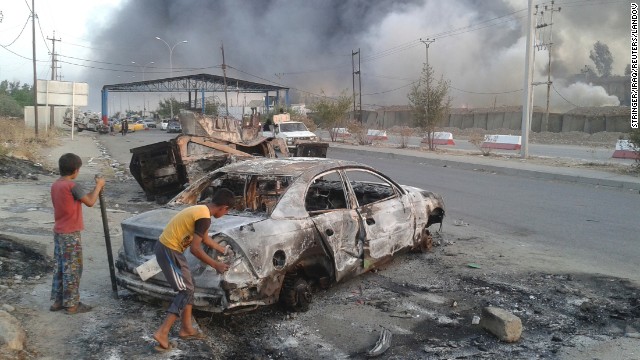 Children stand next to a burnt vehicle during clashes between Iraqi security forces and ISIS militants in Mosul on Tuesday, June 10.
Children stand next to a burnt vehicle during clashes between Iraqi security forces and ISIS militants in Mosul on Tuesday, June 10. 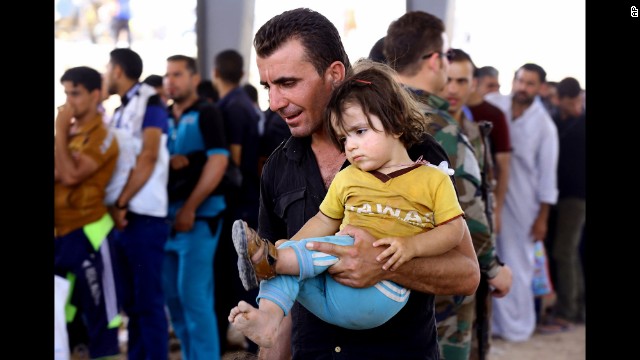 Civilians from Mosul escape to a refugee camp near Irbil, Iraq, on June 10.
Civilians from Mosul escape to a refugee camp near Irbil, Iraq, on June 10.
- Likelihood of foreign fighters planning attacks in West varies by where they were, writer says
- ISIS less interested in planning attacks overseas than al Qaeda, Thomas Hegghammer says
- ISIS is unlikely to go all in on global operations the way al Qaeda has, he says
Editor's note: Thomas Hegghammer is director of terrorism research at the Norwegian Defence Research Establishment and author of "Jihad in Saudi Arabia: Violence and Pan-Islamism since 1979." The views expressed are solely those of the author.
(CNN) -- How big a threat do foreign fighters in Syria and Iraq pose to the West? It's a question that has been much on the mind of policymakers and commentators, especially since U.S. President Barack Obama announced the United States was ramping up its military role in the region. Will such fighters return with dangerous new skills and experience that they are determined to use against their home country? Or is the potential threat by these fighters overhyped?
The answer depends on what the Islamic State of Iraq and Syria decides to do with them. So far, jihadi groups in Syria have not been sending foreign fighters on attack missions in the West in any sort of systematic way. But if the group decides to "weaponize" its fighters, we will have a much bigger problem on our hands.
Since 2011, around 3,000 Western Muslims have gone to Syria, where many have joined the most radical elements of the insurgency. And there is no question that some of these individuals will pose a terrorist threat when they return. We know this because it has already happened -- Syria veterans are suspected of involvement in one successful and at least six unsuccessful alleged attacks in Europe and Australia over the past year.
Yet there is no reason to expect all -- or even a majority -- of these people to try to attack us in the future. During my research, I have found that of all Western Muslims who joined conflict zones before 2011, no more than one in nine moved on to terrorism in the West. In fact, this estimate is probably at the high end -- the real historical average may be closer to one in 15 or 20.
This suggests that the more helpful question is therefore not whether the foreign fighters in Syria are a threat, but what proportion of them will be.
Can we not simply assume that somewhere between one in nine or one in 20 of the fighters in Syria will become terrorists, and try to plan accordingly? Unfortunately, it's not that simple because the "blowback rate" -- the proportion of outgoing fighters who later return to attack -- varies significantly between destinations.
 Obama: Campaign against ISIS long term
Obama: Campaign against ISIS long term  Is U.S. strategy against ISIS working?
Is U.S. strategy against ISIS working?  ISIS' advance brings fear to Baghdad
ISIS' advance brings fear to Baghdad Take the conflict in Somalia, for example, which attracted hundreds of Western foreign fighters in the previous decade, but produced few attacking returnees. In contrast, of those who went to Afghanistan and Pakistan in the same period, a substantial proportion plotted attacks on their return.
So, how can we determine whether Syria will produce foreign fighters that are more like Somalia or more like Afghanistan and Pakistan in terms of blowback?
It largely depends on whether you have a group in the theater of conflict that strategically targets the West. For example, the Afghanistan-Pakistan area has a high blowback rate because it is home to the so-called al Qaeda Central, a group whose sole preoccupation is to mount attacks in the West. Al Qaeda excelled at taking foreign fighters who had come to fight with the Taliban and persuading them to undertake attacks in Europe or the United States instead.
Most other jihadi groups, even al Qaeda's own affiliates, are not equally invested in this strategy. True, they all spout anti-American rhetoric and may even dabble in anti-Western extremist actions. But they invest the bulk of their resources in local operations.
And so far, that has been true of ISIS, too. Of course, if you look for anti-Western statements and links to potential international plots, you will find them. But these indications actually make up a small proportion of the group's overall ideological production and military operations. The fact is that there is little to suggest that ISIS has had a sustained and centrally directed global operations program.
This is one of the reasons why the blowback rate from Syria has so far been low, several plots notwithstanding. Six plots involving a total of, say, 10 or 20 Syria veterans make for a blowback rate of one in 150 or one in 300. Yes, it is still early in the conflict, and several plots may have gone unreported. But Syria is still looking like a low blowback foreign fighter destination.
There is, however, the question of whether Western intervention in Iraq and Syria will cause ISIS to go global. Certainly, the group has taken a more anti-Western posture over the past few months. It has repeatedly threatened to attack the United States, and it has beheaded American hostages in Syria.
In a noteworthy statement, for example, ISIS spokesman Abu Muhammad al-Adnani recently called on supporters worldwide to attack members of the coalition in any way possible. So we should not be surprised if ISIS embarks on a limited but sustained external operations effort, along the lines of al Qaeda in the Arabian Peninsula in Yemen, which combines a primarily local agenda with a small global side operation.
Ultimately, though, ISIS is unlikely to go all in on global operations the way al Qaeda Central has. The organization is not designed for that, and such a strategy is not compatible with its state-building ambitions. Besides, ISIS' threats have so far differed in tone from those of al Qaeda Central. Where the latter says, in effect, that "we're coming at you regardless," ISIS has basically been saying, "We'll come at you if you attack us." It's a somewhat more reluctant declaration of war.
None of this is to suggest that some foreign fighters in Syria won't come back and do bad things regardless of what ISIS' leaders choose to do -- they undoubtedly will. And it is also important to remember one more thing, namely that although the early signs suggest that the threat from foreign fighters returning is low, the potential for attacks is still there.
Indeed, if ISIS starts to "weaponize" its Western recruits in a strategic way, then the foreign fighter threat will take on a more significant -- and more deadly -- complexion than it has so far.
Read CNNOpinion's new Flipboard magazine.
Follow us on Twitter @CNNOpinion.
Join us on http://ift.tt/1bl3g0P.
No comments:
Post a Comment